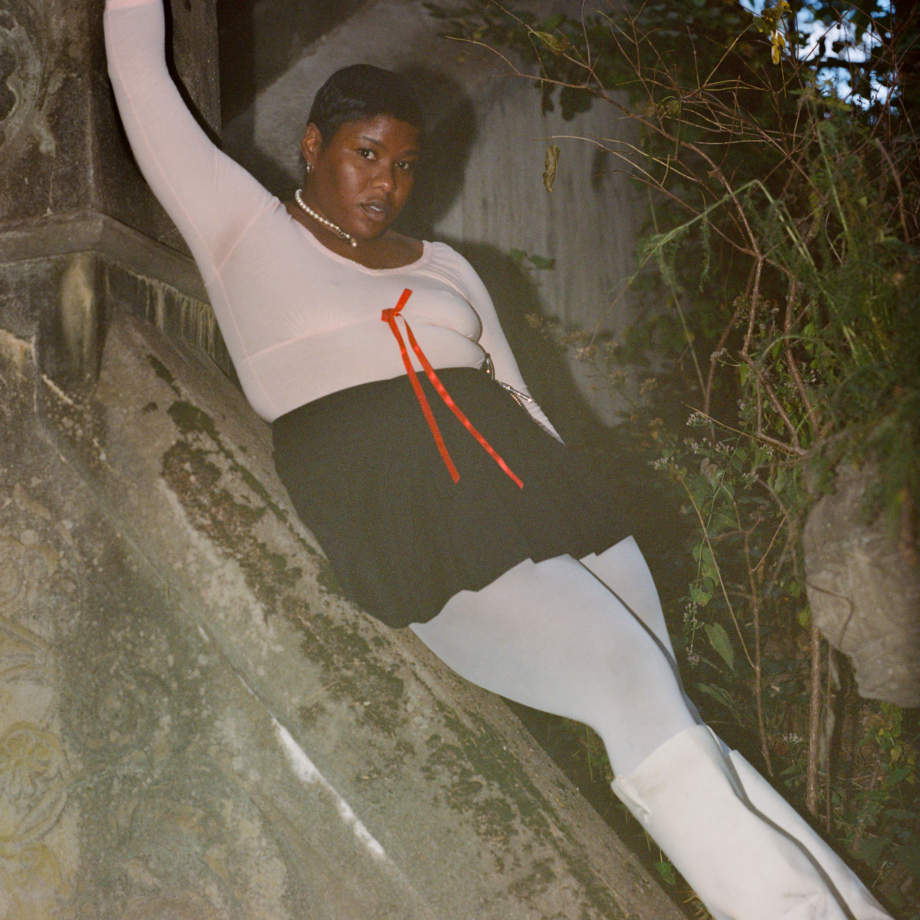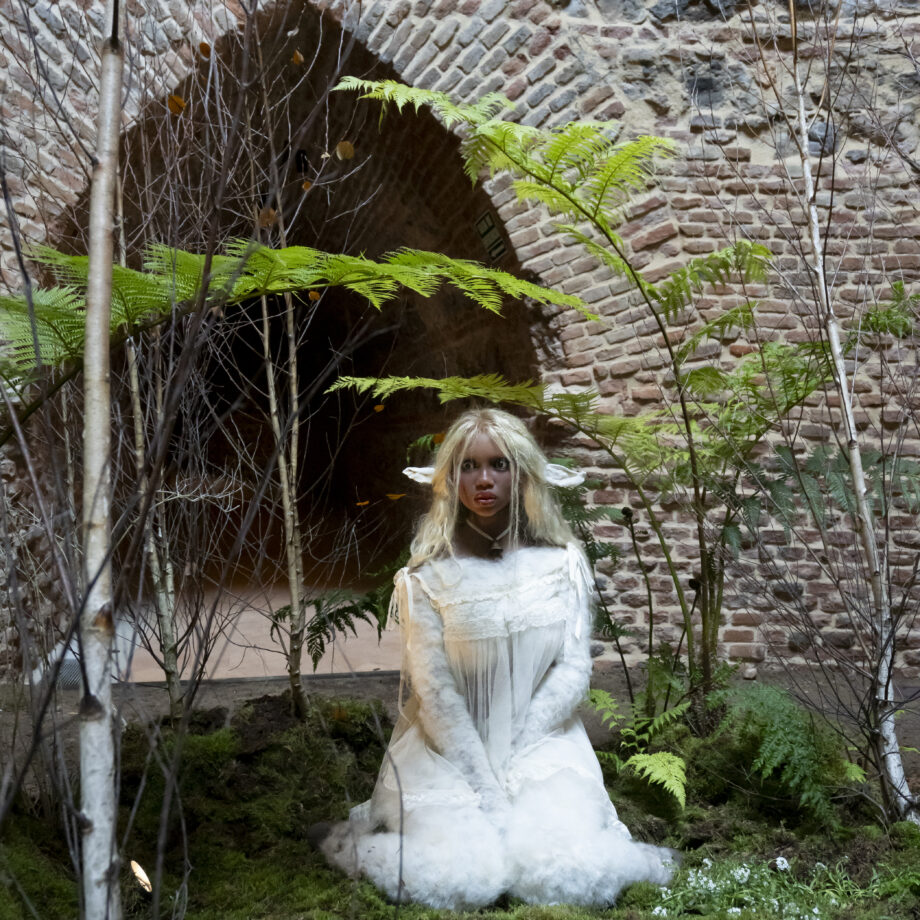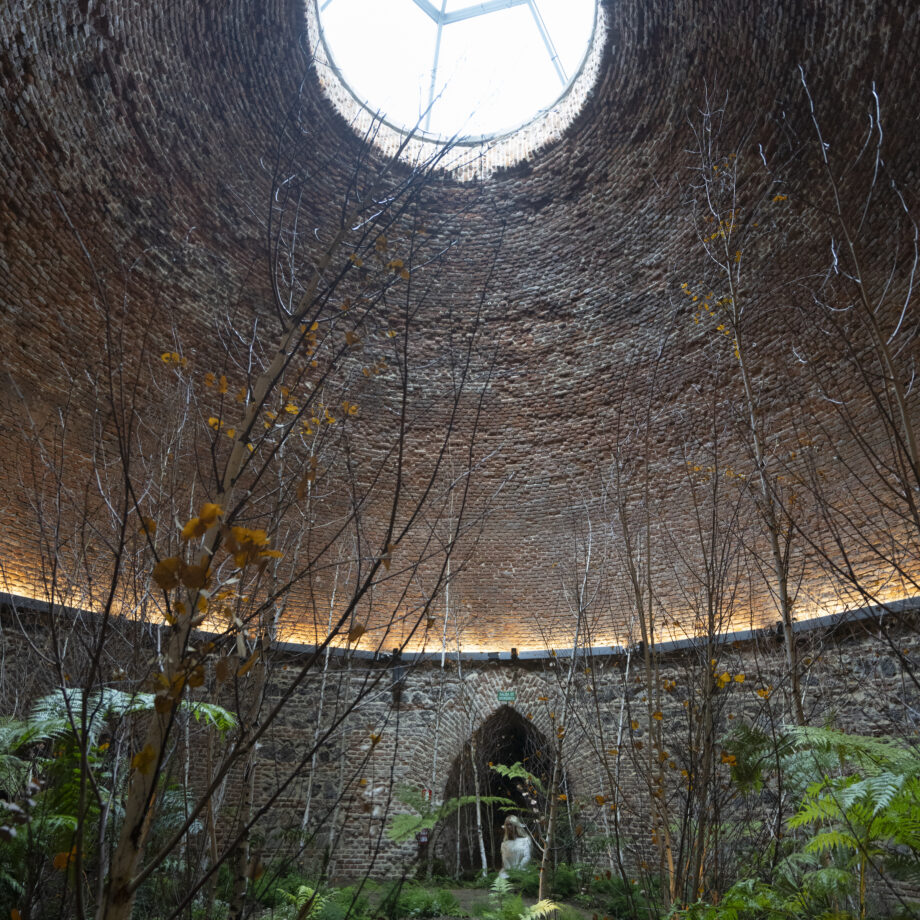
For two more weeks, lies in an unearthed grotto within Madrid’s city centre, a polyphonic perverted paradise within Parco Del Retiro’s Montaña de los Gatos: When The Lambs Rise Up Against the Bird of Prey, the latest installation by multi and interdisciplinary artist Precious Okoymon – recently announced as a participating artist in the Nigerian Pavilion at the 60th Biennale di Venezia. So named in an ode to Anne Boyer’s 2014 poetic essay of the same name, Okoyomon’s installation pays heed to Boyer’s Deleuzian subversion of the lamb as a sacrificial beast: the animal’s perceived naïvete is rejected, related as possessed of a remarkable astuteness, Boyer’s (and Okoyomon’s) lamb challenges the dichotomy of human acuity and a bestial lack of perspicacity.
Commissioned by the Fundación Sandretto Re Rebaudengo, the immersive body of work comprises a series of new pieces: an animatronic lamb sculpture, a score of drawings of flowers with adorning verse, and a new poem. The whole installation resounds with a recapitulation of Alexander Scriabin’s Mysterium conceived in collaboration with J. M Artero: the late great composer’s last, unfinished work, intended to be performed in a weeklong, multisensory event in the foothills of the Himalayas – a synaesthetic coterie culminating with the end of the world, and the succession of the earth into the hands a more worthy race.

The location of the Montaña de los Gatos is perfectly suited to Okoyomon’s morphic practice: one of the follies built by Ferdinand VII within his royal gardens, the space is imbued with an incipient interdependency – a feeling of a primordial essence, where man, animal, nature and poetry operate magically, and in synchronicity. Interrogating intimacy, ontology and phenomenology, the queering and racialisation of both the natural world and digital realm, Okoyomon’s practice populates and provokes within the grotto, leading the viewer to consider the nature of artificiality itself insofar as it plays a role in the apocalyptic.
Amidst Okoyomon’s occupation of the former palatial appendage, I sat down with the interdisciplinary artist to discuss worldbuilding, the seeds of poetry, and gesamtkunstwerk.
Katrina Nzegwu: You are an artist, poet and chef – do you conceive of these epithets as distinct veins? Or do they mutually and reciprocally inform each work that you make?
Precious Okoyomon: Everything is in conversation and bleeds out into one another. Poetry is the overarching umbrella that flows through the work; my installations become capsules of the lived poems. In my latest installation, the soil is a mix of six cooking spices…I don’t believe in the separation of things: everything pollinates, falls and leaks into one another. It’s all the poem of my life, leaving little objects in its wake.
KN: Can you speak about your encounter with Anne Boyer’s When the Lambs Rise Up Against the Bird of Prey?
PO: I’ve known Anne for a long time; I met her the second month after I moved to New York, so 8 or 9 years ago. She invited me to a reading and showed me the text; we talked about walking around Central Park and eating ice cream. I wrote a poem back to her called “The Benediction of the Lamb” – it’s in the note for this show’s book. The text has sat with me for a very long time, and all my work is usually born from poems. I have my own relationship with the lamb that I’ve circled back to; it’s a fascination with birthing. I went to school for philosophy, and I’m constantly thinking about male-dominated Ontologies. Birthing as a concept is an invitation to create one’s own modality and new world.
KN: How do you relate to the figure of the lamb, especially as a symbol in opposition to the typical conceptualisation of it as a sacrificial beast?
PO: The whole show started with the question – what does it mean for the animal whose way is to be sacrificed to already have an awareness of one’s afterlife? – especially thinking through the modality of blackness. I was thinking about the application of the Christian lens of lambs rising up against birds of prey. [Alexander] Scriabin was central to thinking through endings. The question became: what does it mean for the creature who knows its own death to end the world; what is that animal’s prayer?

KN: With reference to the centrality of poetry to your wider practice, are there any other specific writers or verses that a) informed When the Lambs Rise Up…; and b) you return to across your output?
PO: Christina Sharpe. I’ve been intensely re-reading a lot of her work for the last few years. Ordinary Notes, in particular, has shaped my view of (this monstrous) world ending as a holding cocoon of thinking through things. The long libretto I wrote that is sung and played in the Artificial Mountain – I call it a church because it echoes and is this special place – looks back to [Edouard] Glissant’s Sun of Consciousness. This idea of consciousness as a way of ritual led to a new way of receiving understanding – that was what Scriabin was trying to do via his ten-day concert; all participants would be able to create alternative consciousness and receive a new clarity.
KN: You discuss the childhood belief that stemmed from your mother telling you that planting words in soil would make them grow. Can you speak a bit more about this notion?
PO: Writing is the seed that I plant that grows into other things, the fertile soil for everything. My mother always meant it literally, and that type of thinking brewed a type of methodology; to this day, my installations start with soil as a prayer within the chaos that characterises our contemporary. Writing is the only way I know to think through a lot of things – the worlds I create, the objects I make. It’s time-out-of-time research.
KN: Much of your work hinges on the translation of ritual, which is particularly pertinent here with regard to rituals of planting and harvesting. Can you speak a bit more about this? Are there any other daily rituals that you observe?
PO: Writing is a form of exorcism of myself, to continuously arrive at an understanding of something that I can’t escape – namely, archive memory. I meditate; I write every day for clarity in thought and to carve space for dreaming. I’m a very ritual-based person; I need an identical organic routine no matter where I am. I read a poem a day as transference, as a communication with an archive of written memory, constantly. I’m always tucked inside many multitudes of things. Oh, I’m addicted to movement. I’m always hungering for a constant (non)escape from the self.

KN: Can you expand on the statement “Writing is literally writing my fears”?
PO: A lot of my work deals with memory archiving and dreaming, creating new cosmologies and dreaming outside of a current primordial fear and anxiety. This takes a lot of fragilisation, which is a hard thing to do in our world when there isn’t time outside of time, or a mutual person-to-person transference everyday. I’m always playing and living inside this fragilisation; to live past the fear requires knowing the fear. Self analysis – it affords freedom, but it does take constant work. Knowing oneself creates a lot of joy in my work; it allows me to relate to other people. A favourite practice is cooking for and nourishing other people, as another form of transference. Writing and sharing in commune with other people, such as poets – I’ve carved out immense rituals, which function as tools. It’s about how to create an abundance of joy, chaos and worldmaking.
KN: Can you discuss the taxonomic significance of the flora you planted within the garden – were they chosen for specific aesthetic or connotative reasons?
PO: It’s a very specific space, and I wanted to create a sense of what might survive after the end of the world. Birch trees are one of the world’s oldest root systems. They’re always in conversation with one another. I wanted everything to be in direct conversation, like the snowdrops and ferns – soft blooming flowers that come up after struggle, after intense weather conditions. The forest holds a magic quality in its secretiveness, and I wanted to return to a feeling of the woods I grew up around [in midwest Ohio], but infused with the imagination of what they might look like in 20 years. The light in the mountain only comes from overhead; it reminded me of Ohio, in the period between winter and spring, when things are false-blooming. The soil contains cocoa, cinnamon, cayenne, lavender, and star anise… you’re hit with a very specific, sweet scent. It’s a very specific place that does not yet exist, where everything is dying and blooming simultaneously.

KN: The installation enfolds Alexander Scriabin’s unfinished work Mysterium. How/where did you first encounter the work, and what drew you in particular to its recapitulation?
PO: I came to Scriabin young. I have a love of orchestral music. I was part of my school’s chamber orchestra. I’ve dabbled in composing, like for the Aspen Garden [Every Earthly Morning the Sky’s Light touches Ur life is Unprecedented in its Beauty, 2021, Aspen Art Museum], and the Venice installation [The Milk of Dreams, To See the Earth before the End of the World, 2022, La Biennale di Venezia]. Scriabin struggled with the work across the last six years of his life as he slowly went mad. People forget the composer’s intense religiosity and interest in philosophy; he had illusions of grandeur. For me, the end of the world signifies the end of the world we live in – Scribian’s concept was of noble sacrifice. This work is us two artists meeting and shaking hands in the middle. The vision is to dream up new worlds, to take time out of time, to cast a prayer that will echo around and end the world to leave space to usher up a new form.
KN: Scriabin’s programmatic notes are prophetic insofar as the idea that “Everyone will be a participant” has been actualised by the making-ubiquitous of events in our digital/social media age. How do you conceive of his idea of universalisation in relation to this?
PO: I’m always thinking about transference and what one gets to witness (in fragments) without the need for physical presence. I create spaces that conduct moments that require one to immerse oneself and willingly slow down. There is sensory pleasure within the installation. To breathe in – it’s a resetting of the machine of one’s body, activated by poetry. You have to be a witness. It takes a physical response. I think my work asks that of the viewer. You can witness it online, but that’s not the transference of the moment or the space. There’s a moment of sadness, of asking if the work actually does the thing when you see it. A fragment of the prayer to the slowness or the stillness of your body.
KN: Can you discuss the process of collaborating with J. M. Artero?
PO: It was so special in that it was a new collaboration. Previous collaborators like Kelsey Lu and I have a long-lasting friendship; I’ve worked with Gio on several projects, and we’re doing the [2024] Nigeria Pavilion. Working with someone new required a lot of trust in the process, as well as knowing how to articulate both of our visions together with grace. It allowed me to soften in a way I wasn’t used to – I like to see things in my mind in a very specific way. I know what I want. It’s nice to soften into another’s way of knowing, especially with the language barrier, speaking in translation through music. It’s one of my favourite collaborations, and it happened organically.
KN: You’ve been selected to participate in the second Nigerian Pavilion at the 2024 Venice Biennale. Can you talk a bit more about how it feels to represent one’s nation, especially as an artist of the diaspora? Can you offer any insights into the form of/concepts behind the work you’ll present?
PO: I left Lagos at age 7; my dad still lives there. There’s a separate distinction between my life there and my life here in the US, and what it means to hold the two weights of both of them. I have half-siblings who still live there, who are very different. I went back to Lagos in January after seven years, and I felt the evidence of change – I felt sad in many ways for a place I didn’t feel I knew anymore.
I’m making a radio tower as an archive of memory, a pirate radio station. It’s a living organism played by the wind; it’s affected by anything that passes or touches it, translates motion into music, and releases confessions. I conducted 40 interviews over four days [in Lagos], asking strangers the same 12 questions in the vein of Laconian analysis. The answers were a variety of honesty and vulnerability; it felt nice to think through what it means to archive space, memory and feeling in such a fast-changing world. I wanted to do real transference and witness people in a space that enabled them to break down or fragilise with me.
The dream is to continue adding on and having this eternal transmission. I love art, but I love people more… I’m secretly just an existential researcher. Let me into that crack of time!
KN: Curator Hans Ulrich Obrist speaks of the Fundación Sandretto Re Rebaudengo’s exhibition series as intended to “create bridges between different audiences.” What do you think the significance of such gestures is, and how do you conceive of your practice within the framework of this reciprocity?
PO: I’m always thinking through world endings – where practice begins and starts; about how the world is constantly breaking down and rebuilding. The world ends for people every day, mostly black and brown people – what are the bridges we’re building? I wanna know you, and really witness you, and witness the space we can create together in this moment. That’s the ritual, and that’s why I’m so hungry for the pockets we can get outside of time to build bridges and make portals; some people create new gestures.

KN: The installation is your own interpretation of the end of the world. Do you find space to look forward with hope from this apocalyptic interstice? What do you think is important about creative output in the articulation of potential futures?
PO: Unconscious transference, that is at the basis of human coexistence. We’re coming together – that’s the joy of all this, not how you can be an individual. I consent to not being a single being. The coming together precedes being one; as things are breaking, we’re learning how to be with one another. Fragilisation is resistance. It’s building a new co-emergence of understanding how to be with one another in a way that can support us. We are not separate from nature. We are not separate from one another. I am moving towards being together; that’s my continuous apocalypse.

KN: The installation resides in the Artificial Mountain built by Ferdinand VII in the 19th century; notions of diversion, myth and artifice are inherent to its structure and construction. Can you speak a bit more about your relationship with “folly”?
PO: Mythmaking is a huge part of the practice of having understanding of one’s unconscious, and being able to build new fantasies of survival. On my first visit to a hollow mountain that had been closed for 30 years…I was obsessed! With mystical fantasies of other worlds and portals – it felt like a portal in the middle of the park, it felt made for me.
KN: The garden at Retiro was intended to be something of a suspension in time/space, reality/utopia. To what extent did this feed into your installation – either in terms of complement or subversion?
PO: Inside the space, you occupy time outside of time – it felt like I could make a fragment of a prayer for worlding. There’s a book, “After the End of the World” by Pauline Gumms, set 50 years in the future after the current world we know has ended. Archivists from space come to look at things that have been left by us; it’s thinking through the oblivion of what is our world. [The mountain] was opened for me – that’s what was special: finding it in the middle of a summer day when they had to open it for the first time. I just felt I had to whisper my poem inside, and whatever people would receive, they would get.
Written by Katrina Nzegwu






